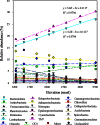Understanding the Linkage between Elevation and the Activated-Sludge Bacterial Community along a 3,600-Meter Elevation Gradient in China
- PMID: 26162883
- PMCID: PMC4561700
- DOI: 10.1128/AEM.01842-15
Understanding the Linkage between Elevation and the Activated-Sludge Bacterial Community along a 3,600-Meter Elevation Gradient in China
Abstract
To understand the relationship between elevation and bacterial communities in wastewater treatment plants (WWTPs), bacterial communities in 21 municipal WWTPs across China, located 9 to 3,660 m above sea level (masl), were investigated by 454 pyrosequencing. A threshold for the association of elevation with bacterial community richness and evenness was observed at approximately 1,200 masl. At lower elevations, both richness and evenness were not significantly associated with elevation. At higher elevations, significant declines with increased elevations were observed for community richness and evenness. The declining evenness trend at the phylum level was reflected by distinct trends in relative abundance for individual bacterial phyla. Betaproteobacteria, Bacteroidetes, and Firmicutes displayed significant increases, while most other phyla showed declines. Spearman correlation analysis indicated that the community richness and evenness at high elevations were more correlated with elevation than with any other single environmental variable. Redundancy analysis indicated that the contribution of elevation to community composition variances increased from 3% at lower elevations to 11% at higher elevations whereas the community composition variance at higher elevations remained much more explained by operational variables (39.2%) than by elevation. The influent total phosphorus concentration, food/microorganism ratio, and treatment process were the three shared dominant contributors to the community composition variance across the whole elevation gradient, followed by effluent ammonia nitrogen and temperature at higher elevations.
Copyright © 2015, American Society for Microbiology. All Rights Reserved.
Figures







Similar articles
-
Ignored fungal community in activated sludge wastewater treatment plants: diversity and altitudinal characteristics.Environ Sci Pollut Res Int. 2017 Feb;24(4):4185-4193. doi: 10.1007/s11356-016-8137-4. Epub 2016 Dec 9. Environ Sci Pollut Res Int. 2017. PMID: 27943140
-
Elevational characteristics of the archaeal community in full-scale activated sludge wastewater treatment plants at a 3,660-meter elevational scale.Water Sci Technol. 2017 Jul;76(3-4):531-541. doi: 10.2166/wst.2017.215. Water Sci Technol. 2017. PMID: 28759436
-
Correlating microbial community compositions with environmental factors in activated sludge from four full-scale municipal wastewater treatment plants in Shanghai, China.Appl Microbiol Biotechnol. 2016 May;100(10):4663-73. doi: 10.1007/s00253-016-7307-0. Epub 2016 Jan 21. Appl Microbiol Biotechnol. 2016. PMID: 26795962
-
Altitude-scale variation in nitrogen-removal bacterial communities from municipal wastewater treatment plants distributed along a 3600-m altitudinal gradient in China.Sci Total Environ. 2016 Jul 15;559:38-44. doi: 10.1016/j.scitotenv.2016.03.175. Epub 2016 Apr 4. Sci Total Environ. 2016. PMID: 27054491
-
Phylogenetic clustering increases with elevation for microbes.Environ Microbiol Rep. 2012 Apr;4(2):217-26. doi: 10.1111/j.1758-2229.2011.00324.x. Epub 2012 Jan 16. Environ Microbiol Rep. 2012. PMID: 23757276
Cited by
-
Ignored fungal community in activated sludge wastewater treatment plants: diversity and altitudinal characteristics.Environ Sci Pollut Res Int. 2017 Feb;24(4):4185-4193. doi: 10.1007/s11356-016-8137-4. Epub 2016 Dec 9. Environ Sci Pollut Res Int. 2017. PMID: 27943140
-
Effects of low temperature on the microbial community of MBBR filler biofilm.Water Sci Technol. 2024 Dec;90(12):3166-3179. doi: 10.2166/wst.2024.391. Epub 2024 Dec 12. Water Sci Technol. 2024. PMID: 39733448
-
Viral and Bacterial Fecal Indicators in Untreated Wastewater across the Contiguous United States Exhibit Geospatial Trends.Appl Environ Microbiol. 2020 Apr 1;86(8):e02967-19. doi: 10.1128/AEM.02967-19. Print 2020 Apr 1. Appl Environ Microbiol. 2020. PMID: 32060019 Free PMC article.
-
Sediment bacterial communities in a eutrophic lake influenced by multiple inflow-rivers.Environ Sci Pollut Res Int. 2017 Aug;24(24):19795-19806. doi: 10.1007/s11356-017-9602-4. Epub 2017 Jul 7. Environ Sci Pollut Res Int. 2017. PMID: 28685337
-
Disentangling the Drivers of Diversity and Distribution of Fungal Community Composition in Wastewater Treatment Plants Across Spatial Scales.Front Microbiol. 2018 Jun 18;9:1291. doi: 10.3389/fmicb.2018.01291. eCollection 2018. Front Microbiol. 2018. PMID: 29967600 Free PMC article.
References
-
- Oerther DB, De los Reyes FL, De los Reyes MF, Raskin L. 2001. Quantifying filamentous microorganisms in activated sludge before, during, and after an incident of foaming by oligonucleotide probe hybridizations and antibody staining. Water Res 35:3325–3336. doi:10.1016/S0043-1354(01)00057-4. - DOI - PubMed
-
- Jaranowska P, Cydzik-Kwiatkowska A, Zielinska M. 2013. Configuration of biological wastewater treatment line and influent composition as the main factors driving bacterial community structure of activated sludge. World J Microbiol Biotechnol 29:1145–1153. doi:10.1007/s11274-013-1273-9. - DOI - PMC - PubMed
Publication types
MeSH terms
Substances
Associated data
LinkOut - more resources
Full Text Sources

